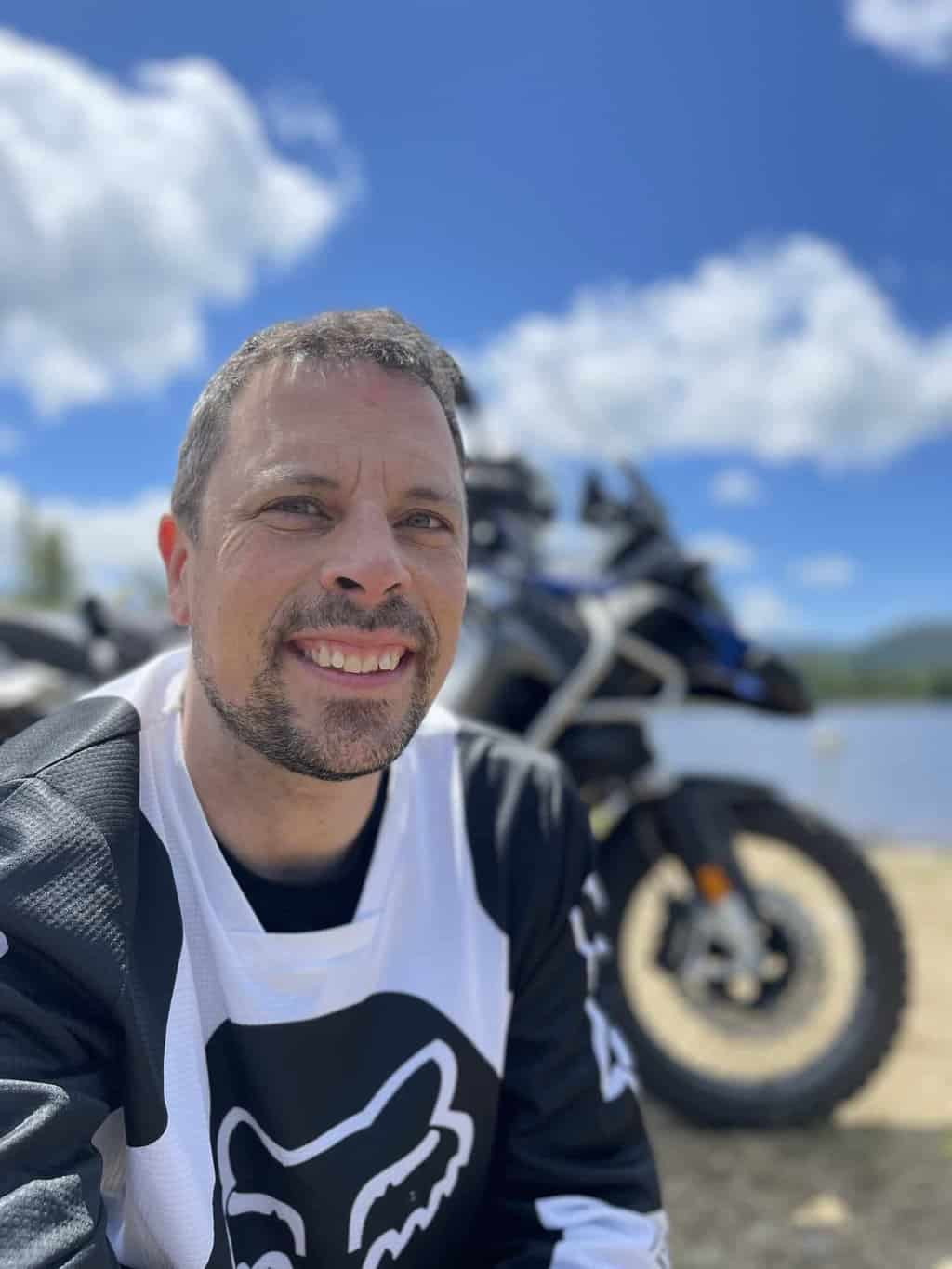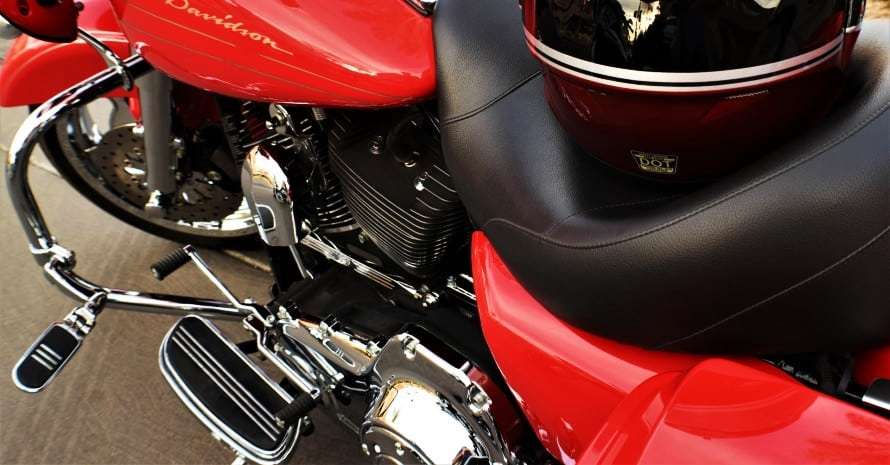An adventure motorcycle is a specially designed motorcycle that is capable of handling rough terrain, long-distance travel, and various weather conditions. It typically has a large fuel tank, a windscreen, a sturdy frame, and suspension, and is equipped with panniers or saddlebags for storage. Some of the key components of an adventure motorcycle include:
- Engine: This is the heart of the motorcycle and provides the power to drive the motorcycle. Adventure motorcycles typically have large engines, ranging from 500 to 1,200 cc, to provide enough power for the rider to handle tough terrain and heavy loads.
- Frame: The frame is the backbone of the motorcycle and holds everything together. Adventure motorcycles typically have a strong, lightweight frame made of aluminum or steel, which provides stability and durability for off-road riding.
- Suspension: The suspension system provides a smooth ride and helps the motorcycle handle rough terrain. Adventure motorcycles typically have long travel suspension, which provides more cushioning for the rider and allows the motorcycle to handle rough terrain better.
- Tires: The tires on an adventure motorcycle are designed to provide traction and stability on various surfaces, from paved roads to gravel and mud. They are typically wider than other types of motorcycle tires and have a more aggressive tread pattern.
- Brakes: The brakes are an important safety feature on any motorcycle, but especially on adventure motorcycles, which may encounter more challenging conditions and require stronger braking power. Adventure motorcycles typically have dual disc brakes, providing more stopping power for the rider.
- Fuel Tank: Adventure motorcycles typically have larger fuel tanks, which provide a longer range between refueling stops. This is important for long-distance travel and off-road riding, where the nearest fuel station may be miles away.
- Windscreen: The windscreen provides wind protection for the rider and helps to reduce fatigue on long rides. Adventure motorcycles typically have taller windscreens, which provide better protection and can be adjusted for the rider’s height and comfort.

It is fairly obvious that the essential parts of a motorcycle are the parts you need to make it move and steer, such as the wheels, handlebars, etc. However, there are other basic motorcycle parts that will help you keep your motorcycle running smoothly, improve its appearance, and keep it in good condition for as long as possible. This guide will show you what these parts are and how they work with your motorcycle frame to keep you safe while you enjoy your ride.
Tires, Wheels, Rims, and Suspension
These parts are, in my opinion, very important. They can make a big difference in the maneuverability of the motorcycle. Usually, the tires and suspension on a stock motorcycle are basic. The suspension is too soft and the tires are more road-oriented than off-road. If you plan on spending your time exploring trails, this is the part you should upgrade second, just after protecting your motorcycle.
Wheels and Rims
If you’re serious about off-roading, I would suggest selling those pretty alloy rims and moving to a spoked wheel. Spoked wheels are stronger and generally more flexible than alloy wheels.
Tires
This is your only contact with the road so you need to choose your tire carefully. There are almost religions created around tire brands and models. Start with the basics, choose for your actual usage, try to correctly evaluate your on and off-road use. Also, take note that generally a better tire wears out faster than a standard tire, there’s a trade-off between traction and lifespan.
Suspension
Needless to say, in off-roading, your suspension will take a beating. Usually, dual-sport motorcycles come with suspension suited for road riding. If you mostly ride with luggage and in rough terrain, you’ll likely need to adjust your suspension. This is especially true with smaller dual sports.
Transmission, Clutch, and Engine
If you’re looking to get into the world of adventure motorcycles, there are a few things you need to know. First and foremost, you need to be able to properly identify the components of your motorcycle.
Transmission
This is how energy from the engine and clutch is transferred to the wheels. To transfer power, there are two types of transmissions. The first is the traditional chain with sprockets at both ends (just like a bicycle). It’s easy to maintain but requires more maintenance than a shaft. With a shaft transmission, you just have to grease and change oil, it’s generally more reliable than a chain and sprocket. Transmission and gearbox are also often mixed together, to keep this article simple, I won’t talk about the gearbox since it’s usually hidden in the engine housing.
Clutch
The clutch is the part that selects whether or not the power from the engine is transmitted to the chain or the shaft. Usually, the clutch is activated from the left lever on the handlebar and is either cable or oil operated. The oil-operated clutch is lighter and easier to pull than the cable-operated clutch, on the other hand, it’s more difficult to repair off-road. There are a variety of clutch systems, but they all work on the same principle. Springs exert pressure on a series of plates, and these plates are like the brake and disk on a standard vehicle. The more pressure, the less the system can turn on its own. So, just like with your brakes, you can control the amount of grip you put on the plate to transmit more or less power from the engine to your transmission.
Engine
This is the heart of the system. Fuel and air are fed into a chamber, they are then compressed and finally ignited. When the explosion occurs, the cylinder is pushed and transfers the force of the explosion to the gears inside the casing. If the explosion is larger, more power is delivered to the gears, which is why the more cc’s you have, the more force the engine will produce. These forces are generally calculated in HP (horsepower).
Seats and Frames
One of the most important aspects of an adventure motorcycle is its seat. You need a comfortable seat that can support you during long trips. Even with a comfortable seat, your butt will hurt after a few days. Usually, the seat that comes with your motorcycle when you buy it is not as comfortable as one you can purchase aftermarket.
The frame ties everything together, so you need to properly protect it. There are many pivot points on the frame that require maintenance. All wheels have bearings, and the swingarms and handlebars also have bearings and bushings. Frame protection is essential if you do off-roading. The skid plate protects the bottom of the motorcycle and frame protection protects the rest. On some models, it’s a good idea to protect other critical parts like the radiator or exhaust.
Controls and Levers
The most important parts of any motorcycle are the controls and levers. These give the motorcyclist the ability to control the speed and direction of the motorcycle. The clutch is on the left side of the handlebar, while the accelerator and brake are on the right. The gear shift is done from the lever on the left side, near the footrest.
All of these controls need to be adjusted to your size and preferences. If you buy a motorcycle and have not adjusted anything, there’s a strong chance that the motorcycle will not be set up correctly for you. The controls and levers need to be protected, for the brake and gear shifter, there is usually no protection possible. On some models, the gear shifter can crack the engine case during an impact, make sure to protect the engine case near this location.
Handguards are essential to protect your fingers from tree branches or rocks that can be thrown by other motorcycles. They also protect your gear shifter and brake lever in case of a fall to the ground.
Electric
This is one of the parts that differ the most between motorcycles. Small dual-sports have virtually no electronics and some models (for example the BMW R1200 GSA) have a lot of electronics. But let’s start with the basics.
Battery
The battery on a dual-sport motorcycle is mainly there to start the bike. After the vehicle is started, all the energy is produced by the generator and the battery is simply recharged.
Lighting
Lighting is the simplest of all electronic devices, it’s just a few switches, wires, and bulbs or LED lights.
Starter
The starter is a small electric motor that starts the engine at start-up. It usually consists of an engine and a clutch that briefly turns the motorcycle engine until the energy from the explosion is sufficient to power the next explosion.
Ignition
For the gas to ignite in the chamber, we need a spark. This spark is generated by a spark plug located at one end of the cylinder. This spark plug is connected to a coil which in turn is connected to a device that times the spark so that it occurs at the right moment.
Safety Switch
All motorcycles have at least two safety switches. One is located on the kickstand and the other on the clutch. It’s important to know where they are because if they break during a ride, they’re easy to bypass to get home without pushing your motorcycle.
All the other stuff
From electronically adjustable suspension to fuel injection, many parts require electronics to work. Generally, the fewer electronics you have, the easier your motorcycle is to maintain. But ease of maintenance is at the expense of comfort and performance.
Conclusion
With this article, you are far from being an expert in motorcycles, but I hope you learned about the basic components of a motorcycle. This knowledge is essential if you are going off-road. Knowing what tools you need based on your motorcycle and being able to locate and understand the function of major parts can help you get out of many bad situations or help a new buddy along a trail. Additionally, you don’t have to be an expert mechanic to temporarily fix things, you just need to understand the basics and find a way to get around problems.

Meet Simon, the 46-year-old aficionado behind YourMotoBro. With a lifelong passion ignited by motocross dreams and a Canadian Tire bicycle, Simon’s journey has been nothing short of extraordinary. From coaching underwater hockey to mastering muddy terrains, he’s an authority in thrill and adventure. Certified as an Off-Road Vehicle Excursion Guide and trained in Wilderness First Aid, Simon’s love for bikes is as diverse as his collection—from a robust BMW GSA R1200 to the memories of a Harley Davidson Night Train. By day a respected telephony consultant, by night a motorcycle maestro, Simon’s tales are a blend of expertise, resilience, and undying passion. ?️✨
